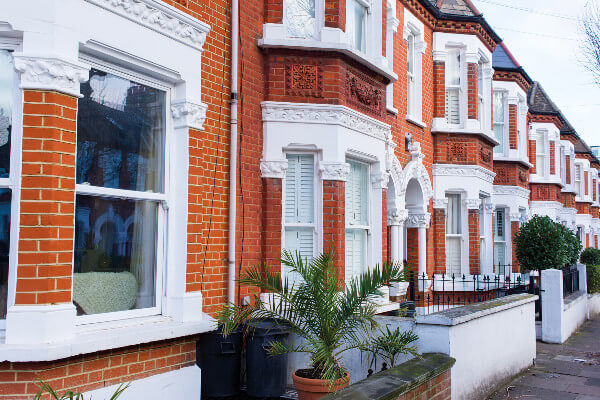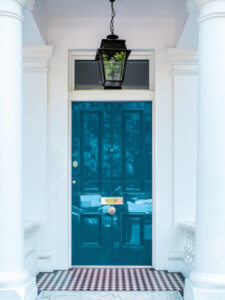TLC for Heritage Homes

If you’re lucky enough to live in a heritage property, look after it carefully, says Stewart Ivory, director of Tring’s Lost Marble Building Conservation. He explains why and how, with some top tips!
Heritage properties are all around us, with approximately a quarter of all UK housing stock built before 1919. That means there’s about 5 million ‘traditionally built’ houses in England, so the chances are that you live in one, live next door to one or walk past one every day without even noticing.
What does traditionally built mean?
A ‘traditionally built’ building is defined as being of solid wall construction (no cavity) from a range of materials including stone, earth, brick, wood and lime. Generally, this means that they will have been built before 1919. Lime was traditionally used for mortar, render, paint and plaster, and enabled the walls to breathe.
Traditionally built houses were designed to behave in a totally different way to a ‘modern construction’. Whereas modern houses are designed to keep the elements out – in effect creating hermetically-sealed boxes, traditional dwellings were built to allow moisture to flow through the very fabric of the building, keeping it dry, even when built on a river or canal.
The use of lime mortar plays a vital role in the process of keeping a building dry. It is produced by burning limestone in lime kilns, and its use goes back many thousands of years – predating the Romans and even the Ancient Egyptians.
Let it breathe!
There are many benefits to the use of lime mortar in traditional buildings irrespective of the historical period or indeed social status of the building itself. Hampton Court Palace was constructed in similar materials to any Victorian estate worker’s cottage and therefore they should both be maintained in the same way, as both need to breathe!
- Lime is breathable – it is porous and vapour permeable
- Lime mortar is traditionally softer than the bricks it adheres to, so that moisture evaporates through the sacrificial bed of mortar
- Lime is flexible and will accommodate some movement and settling of a building
- Lime wash is antibacterial and breathable and was used in cellars, wash-houses and dairies as well as to protect the exterior of buildings
- Timber frames were often lime washed – to protect and preserve, whilst allowing the oak to breathe
- Traditional buildings do not need ‘damp proofing’ as this will prevent them breathing as they were intended to do
So when did things change? Historically, the events of WWI decimated the male population, and the skills and experience often handed down from generation to generation were effectively lost.
Rebuilding bomb-damaged towns and cities and housing an expanding population meant housing needed to be built quickly. Ordinary Portland Cement (OPC) became the go-to material for post-war building, and working with lime became obsolete – its magical properties, benefits and characteristics fading into history. Cement was (and still is) hard, impermeable, quick-setting, easy to use and cheap, which inadvertently created a one-size-fits-all maxim – cement ruled!
The damage is done
But here’s the thing – many, if not most, traditionally built properties have now been subjected to inappropriate and damaging repairs using OPC, from the 1920s onwards. No one, it seems, gave the original materials a second thought – modern was best and that meant using cement for everything. Even in ancient Grade 1 listed churches and castles, cement has been used to the detriment of the original materials.
What the blanket use of cement did was to negate all the manifold benefits of lime, thus creating problems that did not exist before; typically damp through rotting timbers, rapidly decaying stone, collapsing cob walls and disintegrating bricks. Interestingly, cement against a timber beam will cause more rot in 40 years than in the previous 400 years….
Perhaps the most commonplace, and most noticeable, use of cement is in the re-pointing of brickwork, where the joints between bricks are filled with hard cement on top of the original soft lime. Traditionally, lime mortar allowed evaporation, but now the hard cement acts like a bung forcing the moisture into any crevices around the brickwork or back into the internal surfaces of the house. In cold weather this will change to ice crystals, blowing off the face of the brickwork as it expands and tries to escape. Cement render will fare no better – being brittle, cement will crack, allowing water ingress but not allowing it to evaporate out again. Modern plastic paint causes much the same problems. The good news is, these issues can be remedied, with care, but only if the original materials are reinstated.
What you can do
If you are fortunate enough to live in a traditionally built property there are some simple steps you can take to help your property perform as it should – and remember, it needs to breathe:
 Do some research – understand your property (ie. when it was built)
Do some research – understand your property (ie. when it was built)- ‘Stave off decay by daily care’ – the manifesto of the Society for the Protection of Ancient Buildings (SPAB)
- Remove all plants growing up and into your walls
- Lower the external ground level to at least 12 inches below internal levels
- Keep windows open if drying clothes indoors (it is best not to dry clothes on radiators as this will cause condensation)
- Check and regularly clear gutters and drain pipes etc
You will need to enlist the help of specialists for any remedial works such as:
- Removing all the cement pointing in brickwork safely and without damage
- Repointing with lime mortar
- Removing modern gypsum plaster, re-plastering internally using haired lime
- Removing cement render, re-rendering externally using haired lime.
With thanks to Lost Marble Building Conservation – specialists in the safe removal of inappropriate modern materials in traditionally built properties, and reinstating original materials.
They would be delighted to hear from you if you have any questions about this article or if you are thinking about remedial works to get your property dry and breathing again. Get in touch via Instagram, Facebook and Twitter.

